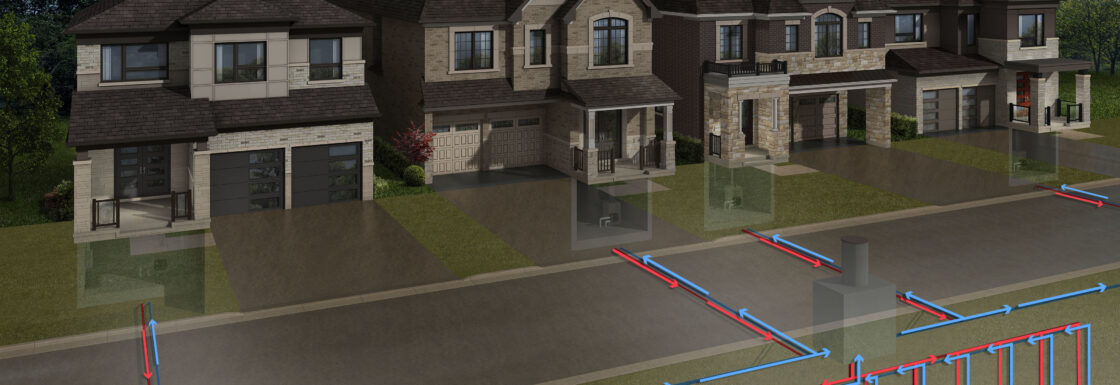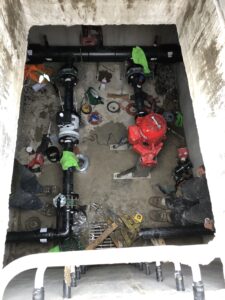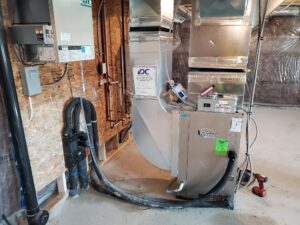Enwave Builds Canada’s largest residential geoexchange community

Projects Sponsor
With the 312-home Markham Springwater Geoexchange Community, Enwave drills down 250 metres to find a more sustainable way to beat the heat (and cold).
With the Markham Springwater Geoexchange Community Project, Enwave wanted to provide an innovative solution to the challenges of providing sustainable, energy-efficient, and market-competitive heating and cooling to urban communities. The Springwater project, the first of its kind in Canada, was developed collaboratively between Mattamy Homes Canada, Enwave Energy Corporation, and the City of Markham, Ontario, where it will grace the northwest of that town, quietly leveraging the Earth’s natural energy to serve as both a heat source and a heat sink for over 300 homes.

The system that makes it tick consists of 144 interconnected boreholes drilled to a depth of 259m each. These boreholes provide primary space heating and space cooling sources for the homes in the community. The district piping, which connects the boreholes to the homes and each other, spans over 2.9 km and ensures efficient delivery of heating and cooling throughout the community, at a fair price too.
With this residential development, Enwave wanted to demonstrate that near net-zero heating and cooling for single-family homes was possible and that it could be done at no additional cost compared with business-as-usual HVAC, and they’ve done just that.

The homes in the Springwater project were built to exceed a stringent building standard (Energy Star for New Homes Standard). The Energy Star standard is a voluntary program that focuses on improving energy efficiency and reducing greenhouse gas emissions in homes. To meet the EnergyStar standard, the Springwater project dwellings underwent rigorous testing and inspections to ensure they meet strict energy efficiency guidelines.
This means that the homes in this community are designed and constructed to be highly energy efficient. They were built ready to become net-zero buildings with the installation of a renewable energy system, and Enwave, who initially proposed a geoexchange opportunity to the City of Markham in 2017, had developed just the innovative and comprehensive geoexchange system to do the trick.
Right from the get-go, the Enwave team performed four thermal conductivity tests to ascertain the ground conditions of the site and determine the feasibility of geothermal within the development. The team also created computer simulation models for different depths and different borehole configuration options. Additionally, they worked with Mattamy to optimize the building envelope for geoexchange (based on the modelling).

A bidding process for the borehole drilling was undertaken and the Enwave team ensured that the drillers had the required ECA permits to perform the work. Research on alternatives to the vertical geoexchange boreholes was also carried out. The implications of having horizontal ‘racetrack-style’ systems and the potential of an open loop geoexchange system (that actively uses groundwater to supply heating and cooling energy) were investigated. The horizontal options were ruled out due to space constraints, and the open loop option was abandoned due to the unknowns on permitting and additional testing to confirm feasibility.
Ultimately the preliminary research informed Enwave’s approach of a single-pipe, low-temperature ambient system with distributed geoexchange boreholes and ground-source heat pumps. This innovative system allows the system to share energy with the community, where during the winter, heat is extracted from the ground and upgraded using water-to-air heat pumps. During the summer, the system rejects heat back into the ground for cooling.

Beyond being a hot new idea, it’s a system you can really sink your heat into.
This approach is particularly noteworthy because it allows for energy sharing within the community; for example, by the extraction of waste heat from one home that is used as a heat source for other homes within the community.
All the research and analysis of the potential benefits of the different types of geoexchange systems included lifecycle costs, energy efficiency, and environmental sustainability. Market testing proving the commercial viability of the project had to be undertaken, and, as that testing predicted, the response from the customer base and community has been overwhelmingly positive. On top of everything else, there’s no air conditioner noise from any of the 312 homes, meaning not just a cleaner and greener community, but a quieter one.
Creating a transferable model that can be replicated in other locations was an important part of the project for Enwave. They’ve demonstrated that sustainable housing options can be energy-efficient and environmentally friendly, and they’re committed to leading the way in this vital area.
The success of the project means they will expand their operations to other communities and help promote environmentally friendly housing options across Ontario, taking the whole province on the journey to the centre of sustainability.













